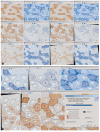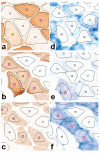Software for muscle fibre type classification and analysis
- PMID: 19683982
- PMCID: PMC3167282
- DOI: 10.4081/ejh.2009.e11
Software for muscle fibre type classification and analysis
Abstract
Fibre type determination requires a large series of differently stained muscle sections. The manual identification of individual fibres through the series is tedious and time consuming. This paper presents a software that enables (i) adjusting the position of individual fibres through a series of differently stained sections (image registration) and identification of individual fibres through the series as well as (ii) muscle fibre classification and (iii) quantitative analysis. The data output of the system is the following: numerical and areal proportions of fibre types, fibre type size and optical density (grey level) of the final reaction product in every fibre. The muscle fibre type can be determined stepwise, based on one set of stained sections while further, newly stained sections can be added to the already defined muscle fibre profile. Several advantages of the presented software application in skeletal muscle research are presented. The system is semiquantitative, flexible, and user friendly.
Figures


References
-
- Andersen LJ, Schiaffino S. Mismatch between myosin heavy chain mRNA and protein distribution in human skeletal muscle fibres. Am J Physiol. 1997;272:C1881–9. - PubMed
-
- Bookstein FL. Principal warps: thin-plate splines and the decomposition of deformations. IEEE transaction on pattern analysis and machine intelligence. 1989;11:567–85.
-
- Brooke MH, Kaiser KK. Muscle fibre types: how many and what kind? Arch Neurol. 1970;23:369–79. - PubMed
-
- Brox T, Kim Y-J, Weickert J, Feiden W. Fully automated analysis of muscle fiber images with combined region and edge based active contours. In: Handels H, Ehrhardt J, Horsch A, Meinzer HP, Tolxdorff, editors. Proc Bildverarbeitung für die Medizin. Springer Verlag; Berlin: 2006. pp. 86–90.
-
- Buche P, Mauron D. Quantitative characterization of muscle fiber by image analysis. Computers and Electronics in Agriculture. 1997;16:189–217.
Publication types
MeSH terms
Substances
LinkOut - more resources
Full Text Sources

